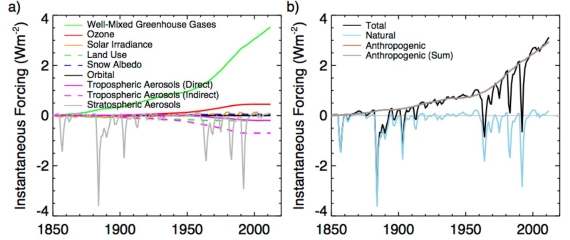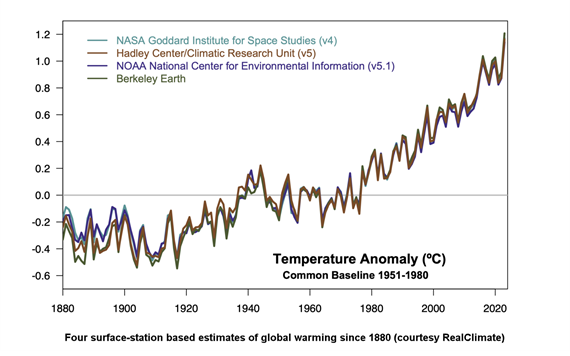 Arguments
Arguments
 Software
Software
 Resources
Comments
Resources
Comments
 The Consensus Project
The Consensus Project
 Translations
Translations
 About
Support
About
Support


Latest Posts
- Skeptical Science New Research for Week #15 2025
- Renewables allow us to pay less, not twice
- Sabin 33 #23 - How much land is used for wind turbines?
- Our MOOC Denial101x has run its course
- 2025 SkS Weekly Climate Change & Global Warming News Roundup #14
- Fact brief - Is Mars warming?
- Skeptical Science New Research for Week #14 2025
- Two-part webinar about the scientific consensus on human-caused global warming
- Sabin 33 #22 - How does waste from wind turbines compare to waste from fossil fuel use?
- Clean energy generates major economic benefits, especially in red states
- 2025 SkS Weekly Climate Change & Global Warming News Roundup #13
- Skeptical Science New Research for Week #13 2025
- Climate skeptics have new favorite graph; it shows the opposite of what they claim
- Sabin 33 #21 - How does production of wind turbine components compare with burning fossil fuels?
- China will need 10,000GW of wind and solar by 2060
- 2025 SkS Weekly Climate Change & Global Warming News Roundup #12
- Skeptical Science New Research for Week #12 2025
- Climate Fresk - a neat way to make the complexity of climate change less puzzling
- Sabin 33 #20 - Is offshore wind development harmful to whales and other marine life?
- Do Americans really want urban sprawl?
- 2025 SkS Weekly Climate Change & Global Warming News Roundup #11
- Fact brief - Is waste heat from industrial activity the reason the planet is warming?
- Skeptical Science New Research for Week #11 2025
- Visualizing daily global temperatures
- Sabin 33 #19 - Are wind turbines a major threat to wildlife?
- The National Hurricane Center set an all-time record for forecast accuracy in 2024
- 2025 SkS Weekly Climate Change & Global Warming News Roundup #10
- Fact brief - Is Greenland losing land ice?
- The Cranky Uncle game can now be played in 16 languages!
- Skeptical Science New Research for Week #10 2025
Archived Rebuttal
This is the archived Basic rebuttal to the climate myth "CO2 is not the only driver of climate". Click here to view the latest rebuttal.
What the science says...
|
Theory, models and direct measurement confirm CO2 is currently the main driver of climate change. |
At a glance
It may come as a surprise to some people unfamiliar with climate science, but tracking down anyone who actually said, "CO2 is the only driver of climate change", has proved most elusive. Thus, the idea that, "CO2 is not the only driver of climate as some would have us believe.", is lacking something rather important. Who actually said it?
In climate science, nobody ever said it. That's because climate science covers everything that affects the climate. If you don't include everything, it would be like trying to find out how an internal combustion engine-powered car works, using as an example one without a crankshaft. The talking-point looks more like an example of a straw man fallacy, in which an argument, claim, or opponent is invented, and then shot down in flames, point-scoring being the idea. One sees this a lot in politics, but not in science.
Through science, we know that Earth's climate is affected by a myriad of drivers that operate on timescales varying from seasons to tens of thousands to tens of millions of years. We've investigated them in depth and we continue to do so. We understand which ones act as 'radiative forcings' - the external, independent primary drivers that determine whether energy is being added to or removed from the system. We likewise understand which ones act as 'feedbacks' - secondary drivers that determine how energy is moved around within the system.
The very nature of science is that it is an ongoing self-correcting process in each and every discipline. So we do understand the key forcings and feedbacks that operate within our climate and on what time-scale they occur. CO2, along with the other greenhouse gases, is but one of these factors.
Before you get too relaxed, however, of all the variables out there, CO2 is the one that has seen a huge change. Since pre-industrial times its concentration has gone up by a whopping 50%. Just imagine if a change of that amount occurred with another part of the climate system. How about the strength of sunlight going up by 50%?
Ironically, at the time of writing (early 2024), there is a lot of discussion as to why 2023 was so warm. The heat came on particularly in the second half of the year, coinciding with the onset of strong El Nino conditions in the Pacific Ocean. But normally there's a lag between El Nino starting up and peak temperatures. Did the injection of unusual amounts of water vapour into the upper atmosphere by the Hunga Tonga-Hunga Ha'apai volcano have a hand? Possibly. Did the cleaning-up of sulphate aerosol-generating shipping fuels partially remove a well-known negative or cooling feedback, and if so by how much?
The trouble is that scientific investigations involve a lot of careful hard work and that takes a lot of time. For people more used to the instant answers of politicians, that might be disappointing, but there's a difference. Science requires evidence, politics less so.
Please use this form to provide feedback about this new "At a glance" section. Read a more technical version below or dig deeper via the tabs above!
Further details
If you have read the at-a-glance section, you will have already realised that the myth that some climate scientist said, "CO2 is the only driver of climate change", is a good example of a straw man fallacy in which an argument, claim, or opponent is invented, and then shot down in flames. But for completeness, let's take a quick look at some other drivers of Earth's climate system.
Natural processes have determined Earth’s climatic history for its 4.56 billion year long existence. However, right at the very end of that time-line, humans have come along and deliberately brought significant change to one mechanism that is driving Earth’s climate into the future.
At any given time, the Earth’s climate is subjected to a myriad of natural climate forcing and feedback processes. The impact of each varies with the magnitude of the natural change. It varies with the duration over which the change occurs and whether or not that change is part of an overall repeated cycle. Cyclic variations tend to cancel themselves out over time. However, remember that time may be orders of magnitude greater than a human lifespan.
Processes that have historically altered the face of the planet include things like cycles in the Earth’s orbit around the Sun or shifts in the planet's tectonic plates. Orbital cycles are potent enough to trigger periods of glaciation in the current Icehouse climate state on Earth. They can also bring us back out of ice-ages, with the help of amplifying climate feedbacks. These large changes take place over tens of thousands of years.
Plate tectonics rearranges continents. It brings them to collision, throwing up mountain ranges. Or it rifts them apart, creating new oceans in the process. But these changes are very slow. Tectonic plates, at their fastest, only move at the same rate at which human fingernails grow, Such geographical rearrangements typically occur over millions of years.
While not nearly as dramatic, the influence of solar, ocean and wind patterns is much more immediate. The El Nino Southern Oscillation (ENSO) is a good example. But the warm phase - El Nino - has a cool counterpart - La Nina. These phenomena swing between warming and cooling respectively, over the course of months to years. So they roughly cancel one another's effects out. Having said that, there are decades during which La Nina or El Nino has been predominant, such as the period from 2000-2012, once popularly referred to by climate science deniers as 'the pause'. All consigned to the dustbin of history now, of course. ENSO involves heat being moved around within the climate system. In a La Nina-dominated decade, that heat is mostly going into the oceans. That's what actually happened in 2000-2012.
Volcanic eruptions and impacts from celestial bodies such as asteroids have a near-instant effect. Luckily though, very few of these one-off events are of sufficient size to impact the global climate for more than a few years. That was not always the case in the deep past, which is why we invest in monitoring such things carefully.
Fig. 1: Instantaneous radiative forcing at the tropopause (W/m2) in the E2-R NINT ensemble. (a) Individual forcings and (b) Total forcing, along with the separate sums of natural (solar, volcanic and orbital) and anthropogenic forcings. Source: GISS.
The industrially-driven increase in CO2 and other greenhouse gases to the atmosphere profoundly differs from such natural processes. This human influence is happening very rapidly (fig. 1). It is not cyclical and it pushes the climate continually and relentlessly in the single direction of warming. And we know we are doing it.
No other species has done this intentionally. The cyanobacteria that oxygenated Earth's atmosphere, starting around 2,450 million years ago, did cause major climatic change as a side-effect. However, nobody can seriously accuse them of having done it on purpose.
Other human-related factors need to be considered too. They include changes in land use, emissions of carbon soot and aerosols. These are all likewise studied individually. However, their net impact is cumulative. Likewise, over the last 50 years of satellite observations of the Earth’s climate, all natural influences have been studied in detail. These include orbital variations, solar output, volcanic activity and changes in both surface and cloud-top albedo. Oceanic fluctuations such as ENSO and the Pacific Decadal Oscillation (PDO) have likewise been tracked as they vary back-and-forth through time.
Natural processes will continue to introduce short term variability in our climate. However, the relentless rise of CO2, now 50% up on pre-industrial levels, has become the dominant factor in determining our planet’s climate now and in the years to come. Other factors like those mentioned above will manifest from time to time over the short term: warmer and cooler years, sometimes singly, sometimes in clusters. These form the irregular noise on temperature graphs (fig. 2) and Realclimate has an interesting recent discussion on the record-breaking 2023 and the factors responsible here. But the bottom line is that all of the graphs show that same long term trend. Upward.
Fig. 2: up and up. Graphic: Realclimate.
Updated on 2015-07-15 by pattimer.
THE ESCALATOR

(free to republish)


























































